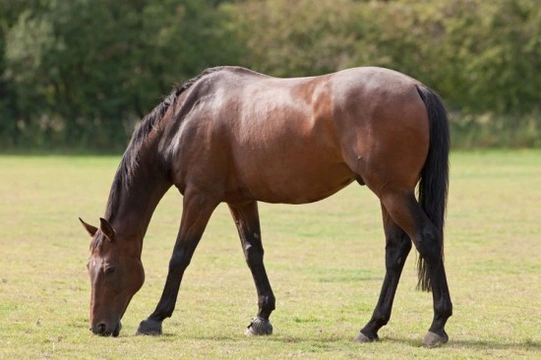
Common diseases and ailments of horses and ponies
As well as representing a significant financial investment, your horse or pony probably means the world to you, and you'll want to keep him healthy and happy. Here is a list of some of the most common ailments and diseases found in horses and ponies.
Arthritis in horses and ponies is a relatively common condition that usually presents itself as the animal grows older. In general terms, arthritis causes inflammation of the joints, increasing the amount of fluid around the joints and sometimes causing visible swelling. Arthritis can be extremely painful, and your horse or pony may show signs of pain or severe discomfort when the affected joints are flexed. Veterinary examination and testing is necessary to confirm diagnosis of arthritis and set up a treatment and management plan for your horse or pony.
Azoturia or Equine Rhabdomyelosis is a painful syndrome that damages areas of muscle tissue in horses and ponies. It can be brought on by a variety of problems such as overfeeding, overworking of a horse in poor condition, hormone imbalances or vitamin deficiencies. Symptoms include hard, painful muscles, reluctance to move, stiffness and a shortened, awkward gait.
Bot flies or 'bots' lay their small (around the size of the head of a pin) bright yellow or orange eggs around a horse's mouth and nose, inner legs and along the top of the mane and tail. Bot eggs should be removed as soon as you spot them with a special type of comb known as a 'bot knife,' to prevent ingestion and potential larval infestation of the stomach.
Colic in the horse is a severe stomach ache, which can potentially prove fatal if accompanied with chronic constipation or twisted gut. This condition can progress quickly and be extremely painful, with symptoms ranging from general signs of discomfort to pawing or snapping at the stomach, repeated lying down and getting back up, rolling, constipation and excessive salivation.
Equine Herpes Virus or Rhinopneumonitis is sometimes called 'the snots.' Infection with the virus is characterised by a white or light coloured nasal discharge. Although this is the basic equivalent of an everyday cold in horses, it is easily transmissible to other horses and ponies and can be serious in animals under two years old.
Equine Infections Anaemia or 'swamp fever' is a serious blood borne retrovirus transmissible through blood, saliva and bodily excretions. Biting insects such as the horse fly are one of the main causes of transmission. It is possible to vaccinate against EIA, although this practice is not widespread in all parts of the country. Symptoms of EIA include recurring fever and anaemia. Some horses can be carriers of the disease without ever being affected themselves.
Equine Influenza symptoms include fever, nasal discharge, possible coughing and general ill health and despondency. 'Horse flu' often resolves itself, but can become serious. It is highly contagious to other horses.
Laminitis is a serious lameness with inflammation of the tissue of the hooves. The hooves will feel hot to the touch, and the horse or pony may well find them extremely painful, and resist having them lifted. The horse may have difficulty moving, and may avoid standing up.
Mud rash (on the legs) and rain scald (on the body) are both caused by the bacterium dermatophilus congolensis. Prolonged exposure to wet or damp conditions such as riding or standing in mud activates the bacteria. Horses with white legs and pink skin are often particularly prone to mud rash.
Symptoms of mud rash and rain scald include loss of hair in the affected area, soreness, sensitivity and scabbing. The early stages of the infection can be treated with an antibacterial wash such as Hibiscrub (chlorhexidine) followed by the application of a barrier cream. The bacteria itself lives underneath the scabs, so in order to treat the condition the scabs must first be removed.
Navicular disease is a painful condition which affects the front heels. Poor shoeing, overwork on hard ground or lack of appropriate hoof care can all lead to a horse or pony suffering from navicular disease. Symptoms include a short, awkward shuffling gait.
Ring worm or dermatophytosis is a fungal infection of the skin, which leads to circular patches of the hair on the horse's body becoming raised, before eventually falling out. Ring worm is not a parasitic worm such as tape worms and round worms are. Ring worm is transmissible to humans and other animals via direct contact and also handling affected materials such as rugs and towels.
Strangles or equine distemper is a highly contagious bacterial infection which causes extreme and painful swelling of the glands around the throat. Without veterinary intervention, this can restrict the breathing and become potentially life threatening.
Tetanus or 'lockjaw' is caused by bacteria entering the body at the site of a wound or open sore. The early signs of tetanus include stiffness and spasms of the jaw, neck, hind legs and any muscles around the site of the original wound.
Thrush is a bacterial infection of the hoof that occurs in the region of the frog. It is characterised by a strong offensive odour, and patches of black infected tissue.
Worms and internal parasites of various types including roundworms, tapeworms and lungworms can all potentially infest your horse or pony. Regular worming can prevent this. Left unchecked, worm infestation can lead to colic, weight loss, poor condition and even death. Fields should not be overgrazed, and manure should be cleared from grazing fields regularly to prevent transmission of worms. Remember that much like ring worm, parasitic worms in horses can also be transmitted to humans and other animals.
Hopefully by now you have a basic understanding of the most common ailments and illnesses which can affect horses and ponies. This list is by no means exhaustive- if you suspect your horse or pony may be becoming ill, seek professional advice from your veterinary surgeon as soon as possible.



